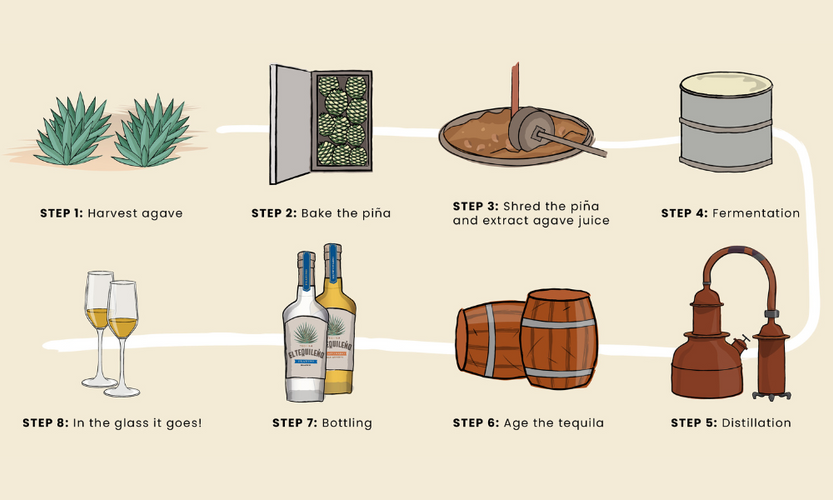How to Make Tequila 101

Making tequila sounds complex, but we're here to tell you it's not. With the right tools, it's pretty easy to make your own agave-based liquor. Follow these simple steps, and you'll have a nice bottle of tequila in no time.
Step 1: Harvest agave
You're going to need a whole mess of agave for this process. It takes about seven years for agave to grow. If you don't have an established crop of your own, get started on that right away. Each plant should yield between 50 and 150 pounds of piña (the heart of the plant), depending on conditions. The bigger the piña, the better.
Step 2: Bake the pina
While it may seem tempting to skip directly to extracting the juice from the plant, you can't do that until you bake it first. You'll want to cook it for about 22 hours at 100°F. Use a pit oven or any other heat-retention device (like a kiln) that will allow you to easily monitor the temperature inside.
Step 3: Shred the pina and extract agave juice
After baking, the pinas are shredded and their juice is extracted by crushing them with a tahona wheel or mechanical shredder. In some cases, this juice is blended with water before being fermented.
Once they're shredded up into little bits, you can squeeze out all of that tasty agave juice into some sort of container like a bowl or something made of clay, like an olla (a traditional Mexican pot), or whatever else you have lying around!
Step 4: Fermentation
After this, fermentation begins. This is when yeast turns the agave juice into alcohol.
The juice extracted from the pinas is fermented with yeast to produce alcohol content that can range between 30-55%. The fermentation process takes several days to complete and has to be done in open tanks so that fermentation gases can escape.
This takes about 3 days. After fermentation, tequila must be distilled twice to reach at least 40% alcohol by volume (ABV).
Step 5: Distillation
After fermentation, distillation takes place. All of the fermented juice is transferred into a still where it will be separated into liquid and vapor states. The vapor is then condensed back into a liquid state, and this liquid is tequila!
Step 6: Age the Tequila
Age the tequila to give it that smooth flavor you love so much. If you're making Blanco or Plata, skip this step—those don't need any aging.
If you want to make other kinds of tequila (reposado or Anejo), they must be aged for at least two months and up to one year (reposado), or one to three years (Anejo). The longer the tequila is aged, the darker the color and stronger its flavor.
Step 7: Bottling
You've made it this far—good for you! Now it's time to bottle your tequila so that you can enjoy the fruits of your labor.
You'll need a funnel and a clean bottle, like a wine or champagne bottle, to do this. Use the funnel to pour the tequila through a strainer into the bottle. This will keep any sediment from getting into your drink, and will also give you a nice, smooth pour every time.
Step 8: In the glass it goes
Now that you have your bottles of homemade tequila, it's time to drink up! When you're ready to enjoy your tequila, serve it in an old-fashioned glass over ice with a lime wedge on the rim of the glass. Or try it in a margarita or as part of another delicious cocktail!
You'll also want to consider what type of glassware you'll be using for your future sipping sessions. A set of six Riedel Tequila Glasses is perfect for sharing with a group, or you can keep them all for yourself—we won't judge!





